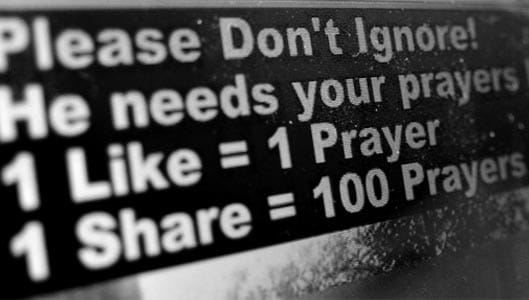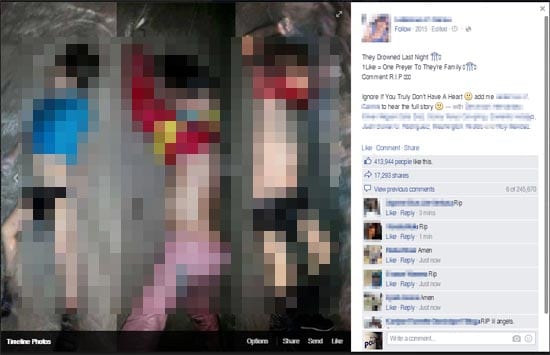5 times like-farming spammers sank lower than low
There are plenty of immoral and vile like-farming scams out there, as our regular readers will be all too aware of.
Like-farming spammers, who try and exploit Facebook users into liking and sharing Facebook posts and following Facebook pages for financial gain, are callous creatures with no evident morals – willing to exploit any situation or event in order to manipulate and deceive Facebook users into interacting with their posts.
Recent events have demonstrated once again that there really is no limit to the depravity like-farming spammers will sink to get their likes.
When enough posts go viral, and consequently their Facebook pages garner sufficient followers, the scammers sell the pages or use them for more serious scams. Whatever route the scammers use, it is always for their financial gain.
Here are 5 examples of when like-farmers spammers have sunk pretty low.
The Syrian Boy
Described by many as one of those photos that will go down in history as an iconic – albeit graphic – moment capturing the European refugee crisis of 2016, the (pixelated) photo below of a drowned Syrian boy who died when trying to reach Greece from Syria has been viewed by millions online, and the photo has appeared on most mainstream media outlets.
It’s also a photo that has been exploited by like-farming spammers who wasted no time in attaching the notorious “1 share = 1000 prayers” template onto it, emotionally exploiting those who see the photo into interacting with it simply to attract followers to like-farming Facebook pages.
We discussed it on our blog here.
Bodies of the coast of Zuwara
In another case involving the European refugee crisis, a set of less publicised photos depicting the bodies of several children who drowned off the coast of Libya when trying to reach Europe have also been used to help attract likes and shares.
Posts showing close up photos of three such children have spread across Facebook claiming that if you ignore the photo (i.e. fail to comment or like it and thus help the Facebook page become profitable) than you “don’t have a heart”.
Deplorable.
Sponsored Content. Continued below...
Exploiting Downs Syndrome
Mother of 5 Terri one day began receiving emails from people claiming that her daughter “Mallory” was having her photo being shared across Facebook. The emails made little sense, however, since Terri didn’t have a daughter named Mallory.
Upon further investigation the truth became clear – Terri’s daughter Katie, who suffers from Downs Syndrome, was indeed having her photo shared across Facebook, accumulating thousands of Likes.
Attached to Katie’s photo was a fake story identifying her as Mallory. The message implored users to like and share the photo to “show their support”.
Spammers had stolen Katie’s photo, created a false story and fake name, and used the photo to make their Facebook post go viral. The full story can be read here on Terri’s blog.
Robbie Middleton
The tale of Robbie Middleton is a difficult one. At the age of 8, he was tied to a tree, doused with gasoline and set on fire. He survived, and lived to the age of 20, with severe burns across the majority of his face and body.
Despite this, like-farming spammers did not appear to hesitate using a photo of him as bait to lure Facebook users into liking and sharing their posts.
Robbie’s photo was attached to photos requesting prayers in the form of likes and shares for their Facebook page.
We wrote about the story here.
Sponsored Content. Continued below...
1000 shares to get heart transplant
In one of the earlier instances of like-farming, where posts would falsely claim that a certain number of shares would result in life-saving surgey, we have this example. The caption here asserts that 1000 shares would allow the baby in the photo to receive a life-saving heart transplant.
However the claim was false, and in fact the baby in the photo had already tragically passed, and certainly not because her post failed to reach the arbitrary amount of likes or shares.
In one of the worst examples of like-farming we’ve seen, the mother (also pictured in the photo) came across these posts featuring her child, since the photo accumulated hundreds of thousands of share from well-meaning but misguided Facebook users. Despite pleas to remove the photos, it kept popping up, time and time again.
–
Like-farming is something that needs to be stopped, especially considering how these these types of spammers benefit in such an abhorrent way. Posts that tell you to like and share them should be treated with extreme skepticism, and Facebook users need to educate themselves to identify like-farming scams so they don’t fall for them.
Whilst no always apparent, there is often a dark sinister side to these posts, and once you understand how it works, you’ll be less likely to hit the share button in the future. So please educate your Facebook friends!
Read more about like-farming here.
3 ways to identify a like-farming page on Facebook.
Keep up-to-date with all our latest articles. Follow us on Facebook, Instagram and Twitter.
Continued below...
Thanks for reading! But before you go… as part of our latest series of articles on how to earn a little extra cash using the Internet (without getting scammed) we have been looking into how you can earn gift vouchers (like Amazon vouchers) using reward-per-action websites such as SwagBucks. If you are interested we even have our own sign-up code to get you started. Want to learn more? We discuss it here. (Or you can just sign-up here and use code Nonsense70SB when registering.)
Become a Facebook Supporter. For 0.99p (~$1.30) a month you can become a Facebook fan, meaning you get an optional Supporter Badge when you comment on our Facebook posts, as well as discounts on our merchandise. You can subscribe here (cancel anytime.)




